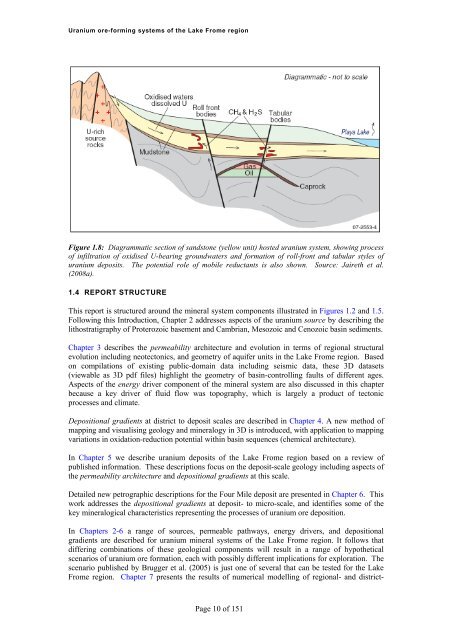Uranium ore-forming systems of the - Geoscience Australia
Uranium ore-forming systems of the - Geoscience Australia
Uranium ore-forming systems of the - Geoscience Australia
Create successful ePaper yourself
Turn your PDF publications into a flip-book with our unique Google optimized e-Paper software.
<strong>Uranium</strong> <strong>ore</strong>-<strong>forming</strong> <strong>systems</strong> <strong>of</strong> <strong>the</strong> Lake Frome regionFigure 1.8: Diagrammatic section <strong>of</strong> sandstone (yellow unit) hosted uranium system, showing process<strong>of</strong> infiltration <strong>of</strong> oxidised U-bearing groundwaters and formation <strong>of</strong> roll-front and tabular styles <strong>of</strong>uranium deposits. The potential role <strong>of</strong> mobile reductants is also shown. Source: Jaireth et al.(2008a).1.4 REPORT STRUCTUREThis report is structured around <strong>the</strong> mineral system components illustrated in Figures 1.2 and 1.5.Following this Introduction, Chapter 2 addresses aspects <strong>of</strong> <strong>the</strong> uranium source by describing <strong>the</strong>lithostratigraphy <strong>of</strong> Proterozoic basement and Cambrian, Mesozoic and Cenozoic basin sediments.Chapter 3 describes <strong>the</strong> permeability architecture and evolution in terms <strong>of</strong> regional structuralevolution including neotectonics, and geometry <strong>of</strong> aquifer units in <strong>the</strong> Lake Frome region. Basedon compilations <strong>of</strong> existing public-domain data including seismic data, <strong>the</strong>se 3D datasets(viewable as 3D pdf files) highlight <strong>the</strong> geometry <strong>of</strong> basin-controlling faults <strong>of</strong> different ages.Aspects <strong>of</strong> <strong>the</strong> energy driver component <strong>of</strong> <strong>the</strong> mineral system are also discussed in this chapterbecause a key driver <strong>of</strong> fluid flow was topography, which is largely a product <strong>of</strong> tectonicprocesses and climate.Depositional gradients at district to deposit scales are described in Chapter 4. A new method <strong>of</strong>mapping and visualising geology and mineralogy in 3D is introduced, with application to mappingvariations in oxidation-reduction potential within basin sequences (chemical architecture).In Chapter 5 we describe uranium deposits <strong>of</strong> <strong>the</strong> Lake Frome region based on a review <strong>of</strong>published information. These descriptions focus on <strong>the</strong> deposit-scale geology including aspects <strong>of</strong><strong>the</strong> permeability architecture and depositional gradients at this scale.Detailed new petrographic descriptions for <strong>the</strong> Four Mile deposit are presented in Chapter 6. Thiswork addresses <strong>the</strong> depositional gradients at deposit- to micro-scale, and identifies some <strong>of</strong> <strong>the</strong>key mineralogical characteristics representing <strong>the</strong> processes <strong>of</strong> uranium <strong>ore</strong> deposition.In Chapters 2-6 a range <strong>of</strong> sources, permeable pathways, energy drivers, and depositionalgradients are described for uranium mineral <strong>systems</strong> <strong>of</strong> <strong>the</strong> Lake Frome region. It follows thatdiffering combinations <strong>of</strong> <strong>the</strong>se geological components will result in a range <strong>of</strong> hypo<strong>the</strong>ticalscenarios <strong>of</strong> uranium <strong>ore</strong> formation, each with possibly different implications for exploration. Thescenario published by Brugger et al. (2005) is just one <strong>of</strong> several that can be tested for <strong>the</strong> LakeFrome region. Chapter 7 presents <strong>the</strong> results <strong>of</strong> numerical modelling <strong>of</strong> regional- and district-Page 10 <strong>of</strong> 151
















